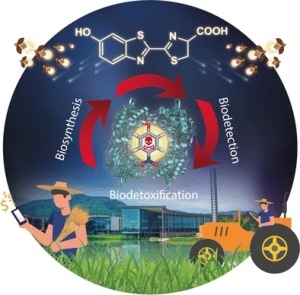Aug 12 2019
Chemicals used in several agricultural and industrial processes can badly affect workers and the environment where they amass.
 A smart chemoenzymatic method detects and removes hazardous phenols. (Image credit: Wiley-VCH)
A smart chemoenzymatic method detects and removes hazardous phenols. (Image credit: Wiley-VCH)
Thai scientists have developed a bioinspired technique to find and detoxify such harmful chemicals in a single step. They have reported in Angewandte Chemie that two natural enzymatic coupling reactions could convert hazardous nitro- and chlorophenols into luciferin, which causes the characteristic glowing in fireflies.
The chemical structure of several organic substances, from lignin and tar, to dyes, pharmaceuticals, and herbicides, includes oxygenated phenol or benzene molecules. Phenol-derived compounds are added to plastics as plasticizers.
Many of these chemicals are not harmful as such, but herbicides, pesticides, or flame-retardants might degenerate into cancerous and stable halogenated phenols and nitrophenols that amass in the environment or workplace.
In general, phenolic compounds are detected using methods like mass spectrometry. At present, Pimchai Chaiyen, a biochemist at the Vidyasirimedhi Institute of Science and Technology, Thailand, and his coworkers have developed a more useful biodetoxification method by combining biochemical and chemical conversion schemes to locate and remove harmful chemicals in a single step.
Luciferin is the key product; it is the bioluminescent compound produced by fireflies mostly seen at night during summer in gardens and in the farmland.
There are many mechanisms available to degrade and detoxify chemicals naturally. In the presence of specialized enzymes, bacteria can dehalogenate phenols and transform them into oxidized compounds known as benzoquinones, which are, in turn, metabolized by organisms. Hence, dehalogenase or mono-oxygenase enzymes have been used in the industry for biological detoxification.
Chaiyen and his team went a step ahead of pure detoxification and combined the two enzymatic processes using a method that can convert the benzoquinone substance into luciferin. They asserted that “The developed chemoenzymatic cascade offers additional value: it provides biodetection technology for nitrophenols and halogenated phenols.”
The chemoenzymatic cascade involves the conversion of benzoquinone from the first enzymatic conversion step into luciferin in the following step, in the same reaction vessel.
They added a natural compound cysteine into the reaction mixture to cause the conversion of benzoquinone into luciferin. By introducing a third step in the reaction sequence, they identified luciferin from the glowing reaction due to the luciferase enzyme, which could also be found in fireflies.
They also confirmed that their detoxification–luciferin production and detection method was powerful and could quantitatively convert hazardous phenols into luciferin.
Removing harmful chemicals and producing luciferin at the same time could offer further benefits. Luciferin is a very important compound in biomedicine. The researchers indicate that their method is a markedly straightforward and useful approach for the analysis and detoxification of the working area in a single step and can be used to prepare luciferin from waste chemicals.